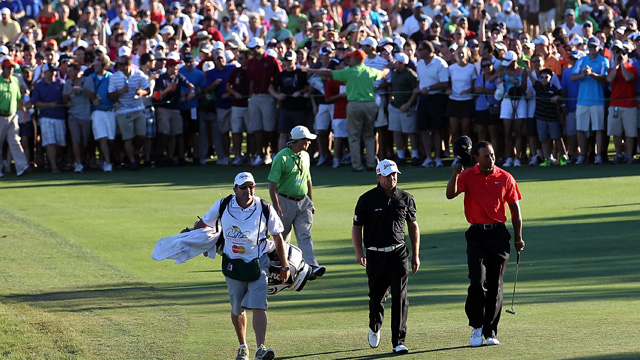NEWS
Does Tiger Really Move Golf's Needle?

He’s back. Or at least he’s back enough that the golf world is abuzz with anticipation.
If you listen to the pundits, this might be the time; the return might be imminent and permanent; a new Green Jacket should be sized to fit his slightly rounder frame; and when it happens, when Tiger Woods is officially back at the top of the charts, all the things in our game that have been off-kilter will return to normal. But is any of that true?
In the two years since “the incident,” no golfer has generated more passion or more heated discussions than Tiger. Hank Haney’s book was the No.1 nonfiction bestseller on Amazon the day it came out, and Tiger is the lead in almost every news story about the Masters.
He had barely gotten his ball out of the hole on the final green at Bay Hill when the first person said, “Having Tiger Woods winning or in contention is good for the game.” In the days since his comeback win, that well-worn generality has been repeated scores of times in my presence and, no doubt, thousands if not millions of times around the country.
But what does it mean? Sure, having Tiger in contention is good for television. NBC ratings for Arnie’s event were up a whopping 120 percent over last year. And, sure, he raises attendance at events as well as awareness and conversation about the game (an elderly lady who wouldn’t know a Rocketballz driver from a Saturn 5 rocket asked me about Tiger at church). But will one more person play golf this week because Tiger won on Sunday? Will one more sleeve of golf balls be sold? One more driver? Will one more minority athlete be inspired to take up the game because Tiger is winning again? And, if so, how long will that new player remain a golfer?
Empirically, the answer is, yes, sure, Tiger has a big impact. Cindy Davis, the president of Nike Golf, can’t speak highly enough of his contribution:
“He has played a key part in building Nike Golf for over a decade,” Davis said. “Being the iconic athlete that he is, consumers pay attention to what he wears and the equipment he plays. If you look at Nike's heritage, it's about athletes. They give insights and feedback on our product innovations. Tiger has an incredible sense of product.”
But rounds of golf worldwide are down, as are retail sales and overall yields at courses throughout the country. There has been a slight uptick in participation in the first quarter of 2012, but most professionals attribute that to the mild winter, not any particular tour player, and certainly not Tiger Woods.
Former PGA of America president M.G. Orender, who runs Hampton Golf, a Florida-based golf management company, told me several months ago that we still have well over 1,000 courses in America that need to close before the supply and demand reach equilibrium. “I see it every day,” he said. “There are courses in every state that are going to lose hundreds of thousands of dollars until the end of days. They need to be turned into parks or nature areas or other useful amenities for their communities, because they aren’t going to make it as golf courses.”
Tiger has the ability to draw eyeballs and drive the conversation about golf, but he can’t save the game from the harsh realities of economics.
He can, however, generate enthusiasm in a certain segment of the population.
“I will almost guarantee you that we will sell more Nike shirts and balls this week than we did last week,” said Joe Debock, PGA head golf professional at Torrey Pines. “Having been a part of the tour event out here for many years, as well as the 2008 U.S. Open, it’s hard to describe the level of energy and enthusiasm (Tiger) brings. When he is in the field or in contention, our numbers go up dramatically, across the board.”
Jenny Judd, one of the PGA head golf professionals at Canongate Golf, suggested that Tiger does have an impact, not in growing the game, but in shifting dollars from one group to another. “We will see an increase in minority play when Tiger is winning,” she said. “It’s a small increase, but it’s there. Unfortunately, it doesn’t affect the overall numbers of our operations by any measurable amount. We might sell a few more Nike balls because of it, but we won’t sell as many Titleist or Callaway balls. In most cases, it’s a wash.”
One week and one win do not portend much of anything. Tiger might go back to his fairway missing ways next week, or he might blow away the field in Augusta as he did in 1997. Either way, he will be the talk of the sport for at least the next couple of weeks, perhaps throughout the summer.
That can’t be a bad thing. The only question is: how much good can Tiger, or any star, really bring to the game and the business of golf? The short answer is: not much. Not anymore. Growing the game is up to all of us who devote our lives to golf and love it every day.
